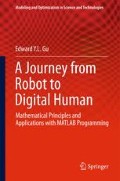Abstract
Digital human modeling has become an active research and development field since 1980’s [1]-[9]. The primary applications include engineering design and validation, digital ergonomic assessment and evaluation, digital simulation and verification of product design and assembling, etc. In history, to simulate a human and motion in a digital environment, people often hired a real person and installed a number of sensors, called a flog of birds, over the entire human body for motion captures. In other words, each sensor would be capable of sensing and transmitting a 3D-coordinate signal at each time instant, and generate a sequence of points as a trajectory by a recorder or a camera. If all the sensors are installed to cover every major marker point over the human body, then a complete motion is captured and ready to playback in a computer. Therefore, the motion capture can reproduce a realistic motion and most Hollywood computer-created movies are made by this technology. The drawback is obvious that each capture can record and generate only one single motion, and has to capture another live motion again for any update or change.
Access this chapter
Tax calculation will be finalised at checkout
Purchases are for personal use only
Preview
Unable to display preview. Download preview PDF.
References
Badler, N., Phillips, C., Webber, B.: Simulating Humans: Computer Graphics Animation and Control. Oxford University Press, New York (1993)
Chaffin, D.: On Simulating Human Reach Motions for Ergonomics Analysis. Human Factors and Ergonomics in Manufacturing 12(3), 235–247 (2002)
Chaffin, D.: Digital Human Modeling for Workspace Design. In: Reviews of Human Factors and Ergonomics, vol. 4, p. 41. Sage (2008), doi:10.1518/155723408X342844
Moes, N.: Digital Human Models: An Overview of Development and Applications in Product and Workplace Design. In: Proceedings of Tools and Methods of Competitive Engineering (TMCE) 2010 Symposium, Ancona, Italy, April 12-16, pp. 73–84 (2010)
Duffy, V. (ed.): Handbook of Digital Human Modeling, Research for Applied Ergonomics and Human factors Engineering. CRC Press (2008)
Abdel-Malek, K., et al.: Santos: A Digital Human In the Making. In: IASTED International Conference on Applied Simulation and Modeling, Corfu, Greece, ADA542025 (June 2008)
Abdel-Malek, K., Yang, J., et al.: Towards a New Generation of Virtual Humans. International Journal of Human Factors Modelling and Simulation 1(1), 2–39 (2006)
Abdel-Malek, K., et al.: Santos: a Physics-Based Digital Human Simulation Environment. In: The 50th Annual Meeting of the Human Factors and Ergonomics Society, San Francisco, CA (October 2006)
Yang, J., et al.: SantosTM: A New Generation of Virtual Humans. In: 2005 SAE World Congress, Detroit, Michigan, USA (2005)
Hamilton, N., Luttgens, K.: Kinesiology Scientific Basis of Human Motion, 10th edn. McGraw Hill (2002)
Watkins, J.: Structure and Function of the Musculoskeletal System. Human Kinetics (1999)
Chaffin, D., Andersson, G.: Occupational Biomechanics, 2nd edn. John Wiley & Sons (1991)
Adrian, M., Cooper, J.: Biomechanics of Human Movement. WCB McGraw-Hill, Boston (1989)
Robertson, D., Caldwell, G., Hamill, J., Kamen, G., Whittlesey, S.: Research Methods in Biomechanics. Human Kinetics (2004)
Chapman, A.: Biomechanical Analysis of Fundamental Human Movements. Human Kinetics (2008)
Griffiths, I.: Principles of Biomechanics and Motion Analysis. Lippincott Williams & Wilkins (2006)
Wilson, A.: Effective Management of Musculoskeletal Injury, A Clinical Ergonomics Approach to Prevention, Treatment, and Rehab. Churchill Livingstone (2001)
Mital, N., Ayoub, A.: Guide to Manual Material Handling. Taylor & Francis, London (1993)
Snook, S., Ciriello, V.: The Design of Manual Handling Tasks: Revised Tables of Maximum Acceptable Weights and Forces. Ergonomics 34(9), 1197–1213 (1991)
Kim, H., Horn, E., Arora, J., Abdel-Malek, K.: An Optimization-Based Methodology to Predict Digital Human Gait Motion. In: Proceedings of 2005 SAE Digital Human Modeling for Design and Engineering, Iowa City, IA, USA, June 14-16 (2005)
Kim, J., Abdel-Malek, K., Yang, J., Marler, T.: Prediction and Analysis of Human Motion Dynamics Performing Various Tasks. International Journal of Human Factors Modeling and Simulation 1(1), 69–94 (2006)
Yang, J., Pitarch, E., Kim, J., Abdel-Malek, K.: Posture Prediction and Force/Torque Analysis for Human Hands. In: Proceedings of 2006 SAE Digital Human Modeling for Design and Engineering, Lyon, France, July 4-6 (2006)
Gu, E., Teng, Y., Oriet, L.: A Study of Human Joint-Torque Distribution for Optimal Posture Auto-Generation. In: Proceedings of the 2002 SAE International Conference on Digital Human Modeling for Design and Engineering, Munich, Germany, pp. 421–430 (June 2002)
Gu, E., Teng, Y., Oriet, L.: A Minimum-Effort Motion Algorithm for Digital Human Models. In: Proceedings of the 2003 SAE International Conference on Digital Human Modeling for Design and Engineering, Montreal, Canada, June 17-20, Paper number: 2003-01-2228 (2003)
Author information
Authors and Affiliations
Corresponding author
Rights and permissions
Copyright information
© 2013 Springer-Verlag Berlin Heidelberg
About this chapter
Cite this chapter
Gu, E.Y.L. (2013). Digital Human Modeling: Kinematics and Statics. In: A Journey from Robot to Digital Human. Modeling and Optimization in Science and Technologies, vol 1. Springer, Berlin, Heidelberg. https://doi.org/10.1007/978-3-642-39047-0_9
Download citation
DOI: https://doi.org/10.1007/978-3-642-39047-0_9
Publisher Name: Springer, Berlin, Heidelberg
Print ISBN: 978-3-642-39046-3
Online ISBN: 978-3-642-39047-0
eBook Packages: EngineeringEngineering (R0)

